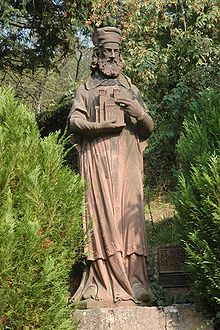Murbach Abbey
Murbach Abbey (Kloster Murbach) was a once famous Benedictine monastery in southern Alsace, in a valley at the foot of the Grand Ballon in the Vosges.

The monastery, near the community of Guebwiller (Gebweiler in German), was founded in 727 by a certain Count Eberhard, and established as a Benedictine house by Saint Pirmin. Its territory once comprised 3 towns and 30 villages. The buildings, including the abbey church, one of the earliest vaulted Romanesque structures, were laid waste in 1789 during the Revolution by the peasantry and the abbey was dissolved shortly afterwards.
Of the Romanesque abbey church, dedicated to Saint Leger, only the transept remains with its two towers, and the east end with the quire. On the site of the nave is now a burial ground.
History
The founder of the abbey, Count Eberhard, brother of Luitfrid of the Etichonen, brought Bishop Pirmin from Reichenau Abbey on the Bodensee to build up the religious community, which had previously used the Rule of St. Columbanus and become ill-disciplined. Pirmin solved the difficulty by introducing the Rule of St. Benedict.

Count Eberhard gave the abbey a rich endowment and extensive privileges, including the right of free election of the abbot. The monastery was obliged to have its privileges regularly confirmed and was thus closely dependent on the Pope and the Emperor (after 1680 the King of France). Murbach was placed under the patronage of Saint Leger, who had introduced the Benedictine Rule into Burgundy in the 7th century.
The abbey was important politically, and Charlemagne himself took the title "Abbot of Murbach" (Pastor Murbacencis) (in a secular sense) in 782-783.
By about 850 Murbach had become one of the intellectual centres of the Upper Rhine; the library contained about 340 works of theology, grammar and history. At the same time the worldly possessions of the abbey were increasing, thanks to large numbers of gifts. Murbach owned properties and rights in about 350 localities. Most of them were in Alsace, in the Bishoprics of Basle and Strasbourg. In addition there were properties on the right bank of the Rhine and even in the Black Forest. For example, in 805 the Alemannic nobles Egilmar, Focholt, Wanbrecht and Nothicho gave to the abbey their land and a church in the present Grissheim ("villa Cressheim in pago Brisachgaginse"). Further, the abbey acquired the territory of Lucerne in Switzerland and owned besides a whole series of estates in the Palatinate, near Worms and Mainz.
This first period of prosperity ended in 936 with the invasion of Alsace by Hungarians. By the 13th century the abbey had recovered and was able once again to play an important role in Alsace and the region of the Rhine.
From the 14th century the abbey began gradually to decline in influence. In the 15th and 16th centuries Murbach was a principality, and between 1680 and 1789 was enmeshed in the tensions between the King of France and the Empire. In 1759 the monks gave up the Benedictine Rule and the monastery became a collegiate foundation for members of the nobility. In 1789 the French Revolution and the rioting peasants gave the abbey its death blow.

References
- Legin, P. Die Abtei Murbach
- Otto Feld (1961). "Zur Baugeschichte der Klosterkirche Murbach". Zeitschrift für Kunstgeschichte. 24 (3/4): 242–249.
